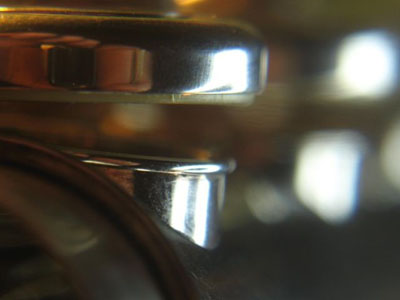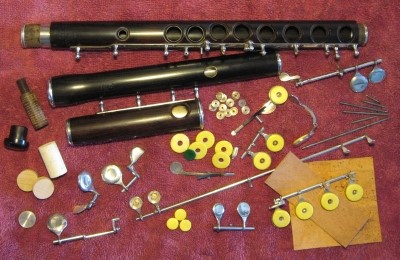
My first piece of advice to the would be do-it-yourself repairman is: practice repairing on a clarinet!
Replacing the pads on a flute is much more difficult than it looks. First, any excess motion has to be removed from the key mechanism. The tone holes have to be leveled, and if they’re rolled that can be tricky! If possible it’s better to raise up the low points than it is to file down the high points. The file that’s used for leveling flute tone holes is a #6 cut…that’s SUPER fine. Those are usually only available through jewelry supply businesses.
If you’re thinking about buying a set of pads, you’ll also need an assortment of shims. Flute pads are not glued in, as are clarinet and sax pads (except for the C key and the trill keys). The procedure is to guess about how many shims to use to level the pad. Put the key on the body and note if shims need to be added or removed to get it close to level. Once it’s pretty close from front to back, check the pad from side to side and adjust by shifting the pad cup. Now that the pad is pretty darn close all around, look for spots where the pad isn’t touching and use partial shims (cut in wedges) to fill in the low spots. The most commonly used shims for the final fit are between .002” and .004”, but in some cases it can be necessary to use shims that are only .001”.
A word about polishing: don’t use liquid polish on a flute with the keys on! It will only make a mess, and there’s no way to get the liquid polish out from under the keys. Even with the keys off you have to be very careful working under the springs. If you’re very ambitious and want to machine polish the keys, use a very light touch. I don’t really recommend trying to machine polish the body without removing the springs, so it’s simply easier to hand buff it using a high quality silver polish and very soft rags (pajamas make excellent polishing clothes!).
When I do an overhaul on a solid silver flute it is possible to do a “like new flawless finish”, but that’s very time consuming. For production model flutes (Yamaha, Artley, Armstrong, Gemeinhardt, etc) I recommend removing the dents and major scratches before doing a high polish (one step under a “like new” finish).


